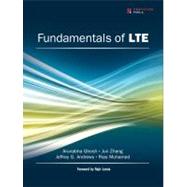
Note: Supplemental materials are not guaranteed with Rental or Used book purchases.
Purchase Benefits
What is included with this book?
Jun Zhang is a visiting assistant professor in the Department of Electronic and Computer Engineering at the Hong Kong University of Science and Technology. He received his B.Eng. in electronic engineering from the University of Science and Technology of China (USTC) in 2004, his M.Phil. in information engineering from the Chinese University of Hong Kong (CUHK) in 2006, and his Ph.D. in electrical and computer engineering from the University of Texas at Austin in 2009. He was an intern at AT&T Labs in the summers of 2007 and 2008.
Jeffrey G. Andrews is an associate professor in the Department of Electrical and Computer Engineering at the University of Texas at Austin, where he is the director of the Wireless Networking and Communications Group. He received his B.S. in engineering with high distinction from Harvey Mudd College, and his M.S. and Ph.D. in electrical engineering from Stanford University. Dr. Andrews has industry experience at companies including Qualcomm, Intel, and Microsoft, and is the co-recipient of three IEEE best paper awards and the National Science Foundation CAREER Award.
Rias Muhamed is a director of business development with the AT&T Corporate Strategy and Development Team. His area of focus is on developing and incubating new business applications and services for AT&T using emerging technologies. He was previously with AT&T Labs, where he led technology assessment of a variety of wireless communication systems. He received his B.S. in electrical engineering from Pondicherry University, India in 1990; his M.S. in electrical engineering from Virginia Tech in 1996; and his M.B.A. from St. Edward University in Austin in 2000.
Preface xix
Acknowledgments xxi
About the Authors xxiii
List of Acronyms xxv
Chapter 1: Evolution of Cellular Technologies 1
1.1 Introduction 1
1.2 Evolution of Mobile Broadband 3
1.3 The Case for LTE/SAE 23
1.4 Key Enabling Technologies and Features of LTE 28
1.5 LTE Network Architecture 33
1.6 Spectrum Options and Migration Plans for LTE 35
1.7 Future of Mobile Broadband—Beyond LTE 39
1.8 Summary and Conclusions 41
Part I: LTE Tutorials 45
Chapter 2: Wireless Fundamentals 47
2.1 Communication System Building Blocks 47
2.2 The Broadband Wireless Channel: Path Loss and Shadowing 48
2.3 Cellular Systems 56
2.4 The Broadband Wireless Channel: Fading 62
2.5 Modelling Broadband Fading Channels 69
2.6 Mitigation of Narrowband Fading 82
2.7 Mitigation of Broadband Fading 92
2.8 Chapter Summary 94
Chapter 3: Multicarrier Modulation 99
3.1 The Multicarrier Concept 100
3.2 OFDM Basics 103
3.3 OFDM in LTE 109
3.4 Timing and Frequency Synchronization 110
3.5 The Peak-to-Average Ratio 116
3.6 Single-Carrier Frequency Domain Equalization (SC-FDE) 124
3.7 The Computational Complexity Advantage of OFDM and SC-FDE 127
3.8 Chapter Summary 130
Chapter 4: Frequency Domain Multiple Access: OFDMA and SC-FDMA 133
4.1 Multiple Access for OFDM Systems 134
4.2 Orthogonal Frequency Division Multiple Access (OFDMA) 138
4.3 Single-Carrier Frequency Division Multiple Access (SC-FDMA) 142
4.4 Multiuser Diversity and Opportunistic Scheduling 144
4.5 OFDMA and SC-FDMA in LTE 152
4.6 OFDMA System Design Considerations 155
4.7 Chapter Summary 160
Chapter 5: Multiple Antenna Transmission and Reception 167
5.1 Spatial Diversity Overview 168
5.2 Receive Diversity 171
5.3 Transmit Diversity 174
5.4 Interference Cancellation Suppression and Signal Enhancement 186
5.5 Spatial Multiplexing 192
5.6 How to Choose Between Diversity, Interference Suppression, and Spatial Multiplexing 200
5.7 Channel Estimation and Feedback for MIMO and MIMO-OFDM 202
5.8 Practical Issues That Limit MIMO Gains 208
5.9 Multiuser and Networked MIMO Systems 209
5.10 An Overview of MIMO in LTE 213
5.11 Chapter Summary 215
Part II: The LTE Standard 225
Chapter 6: Overview and Channel Structure of LTE 227
6.1 Introduction to LTE 228
6.2 Hierarchical Channel Structure of LTE 234
6.3 Downlink OFDMA Radio Resources 241
6.4 Uplink SC-FDMA Radio Resources 251
6.5 Summary and Conclusions 255
Chapter 7: Downlink Transport Channel Processing 257
7.1 Downlink Transport Channel Processing Overview 257
7.2 Downlink Shared Channels 268
7.3 Downlink Control Channels 276
7.4 Broadcast Channels 283
7.5 Multicast Channels 284
7.6 Downlink Physical Signals 285
7.7 H-ARQ in the Downlink 290
7.8 Summary and Conclusions 293
Chapter 8: Uplink Transport Channel Processing 295
8.1 Uplink Transport Channel Processing Overview 296
8.2 Uplink Shared Channels 298
8.3 Uplink Control Information 301
8.4 Uplink Reference Signals 309
8.5 Random Access Channels 313
8.6 H-ARQ in the Uplink 315
8.7 Summary and Conclusions 317
Chapter 9: Physical Layer Procedures and Scheduling 319
9.1 Hybrid-ARQ Feedback 319
9.2 Channel Quality Indicator (CQI) Feedback 322
9.3 Precoder for Closed-Loop MIMO Operations 333
9.4 Uplink Channel Sounding 337
9.5 Buffer Status Reporting in Uplink 337
9.6 Scheduling and Resource Allocation 339
9.7 Semi-persistent Scheduling for VoIP 344
9.8 Cell Search 346
9.9 Random Access Procedures 348
9.10 Power Control in Uplink 350
9.11 Summary and Conclusions 352
Chapter 10: Data Flow, Radio Resource Management, and Mobility Management 355
10.1 PDCP Overview 359
10.2 MAC/RLC Overview 363
10.3 RRC Overview 369
10.4 Mobility Management 371
10.5 Inter-cell Interference Coordination 377
10.6 Summary and Conclusions 380
Index 383
The New copy of this book will include any supplemental materials advertised. Please check the title of the book to determine if it should include any access cards, study guides, lab manuals, CDs, etc.
The Used, Rental and eBook copies of this book are not guaranteed to include any supplemental materials. Typically, only the book itself is included. This is true even if the title states it includes any access cards, study guides, lab manuals, CDs, etc.